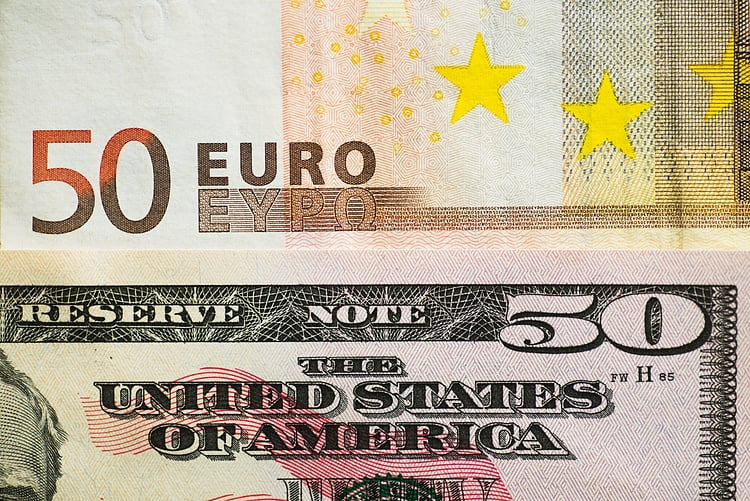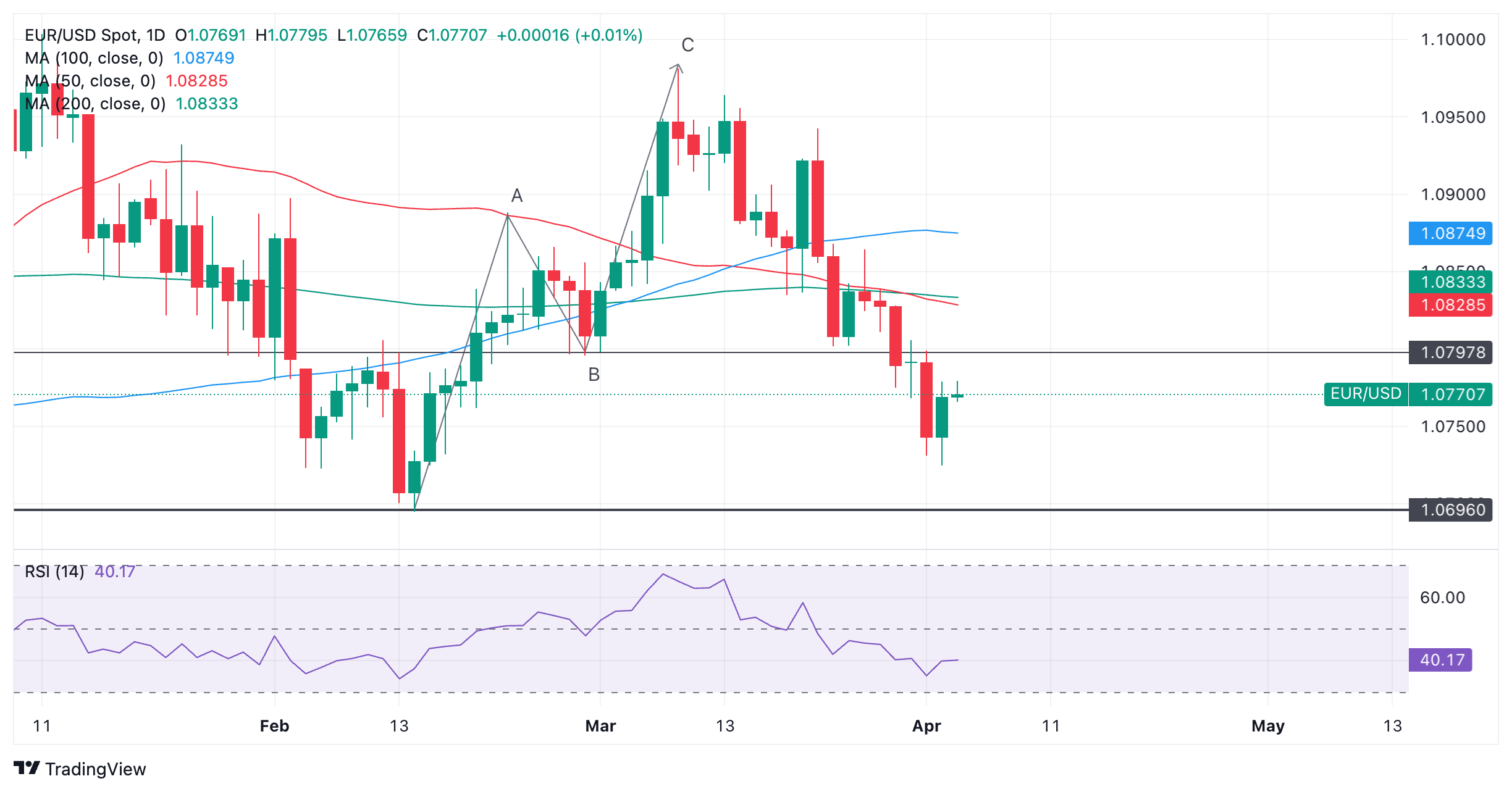- EUR/USD is rebounding from intraday-chart oversold lows.
- Eurozone inflation data on Wednesday could impact interest-rate expectations and the exchange rate.
- The recovery could rise a little further but the short-term trend remains bearish.
EUR/USD is edging higher on Wednesday, making it back into the 1.0770s and extending the previous day’s rebound from six-week lows. It is still too early to say whether the move is corrective in nature or a reversal of the dominant short-term downtrend – but probably the former.
The pair has been bearish since the second week of March, mainly on the back of shifting expectations regarding the outlook for interest rates in Europe and America. In the US, borrowing costs are expected to remain higher for longer, supporting the US Dollar (USD), since higher interest rates attract more foreign capital inflows. This view is unlikely to change much.
EUR/USD: It’s all down to interest rate expectations
On both sides of the Atlantic inflation has been falling, removing the necessity for high interest rates. However, in the US the process has been slower and experts are not as confident it is on its way down to the Fed’s 2.0% target in a sustainable fashion.
Most economists had expected both the European Central Bank (ECB) and the US Federal Reserve (Fed) to begin cutting interest rates at about the same time, in June or thereabouts. However, more recently the outlook has started diverging, with the Fed seen as possibly delaying and the ECB as bringing forward the moment.
EUR/USD rebounded from six-week lows in the 1.0720s on Tuesday although it is unclear what prompted the move. It may have been predominantly technical in nature due to indicators reaching oversold readings on intraday charts.
It is also possible that commentary from Federal Reserve Bank of San Francisco President Mary Daly may have contributed marginally to the recovery as she struck a dovish tone, saying “three rate cuts this year as a ‘reasonable’ baseline,” although she added that three rate cuts was “not a promise.” However, there was no immediate reaction from prices when her words hit the wires.
The HCOB Eurozone Manufacturing PMI could also have provided a catalyst for EUR/USD’s recovery, after it was revised up to 46.1 in March from a flash estimate of 45.7. However, it remains below 50 and therefore in contraction territory. Additionally, the US ISM manufacturing PMI on Monday was even better and actually rose above 50 to 50.3 in March – reaching growth territory for the first time since November 2022.
On the horizon
On Wednesday, EUR/USD could be impacted by Eurozone inflation data when the Harmonized Index of Consumer Prices (HICP) and the Unemployment Rate are released at 09:00 GMT. If HICP inflation is shown to have cooled considerably then it could weaken the pair as it will increase the chances of an even earlier interest-rate cut from the ECB, raising even the possibility of a cut in April.
German inflation data, which came out on Tuesday, ticked lower to 2.2% YoY in line with expectations and below the 2.5% in February. The German Harmonized Index of Consumer Prices, however, fell short of expectations at 2.3%, suggesting a risk of a similar weakness for Eurozone-wide HICP.
In the US the main data release on Wednesday will probably be ADP Employment Change at 12:15 GMT, seconded by the final S&P Global Services PMI and the ISM Services PMI. Services inflation is seen as one of the stickiest components in the CPI basket so markets may pay extra attention if the real figure diverges from expectations.
More Fedspeak is also in the offing with Fed’s Bowman, Goolsbee, Barr, Kugler, and Powell all due to speak.
Technical Analysis: EUR/USD bounces off new lows
EUR/USD rebounded from short-term multi-week lows in the 1.0720s on Tuesday and in the process formed a bullish Piercing Line Japanese candlestick reversal pattern on the daily chart. This occurs when price makes a new low but on the same day recovers and closes above the midpoint of the previous day.
The pattern could indicate a temporary continuation of the rebound higher, with the next key resistance coming into play at the resistance level from the swing low (and B wave low of the prior ABC pattern) at 1.0798.
Euro versus US Dollar: Daily chart
The pair is in a short-term downtrend, however, and this is likely to continue once the pullback runs out of steam.
The 1.0694 February and year-to-date lows are an obvious next target to the downside and also likely to provide substantial support, with a bounce likely at the first test. A decisive break below, however, would usher in another bout of weakness, and target the 1.0650s.
A decisive break is one characterized by a long red down candle breaking cleanly through the level and closing near its low, or three consecutive red candles breaching the level.
Euro FAQs
The Euro is the currency for the 20 European Union countries that belong to the Eurozone. It is the second most heavily traded currency in the world behind the US Dollar. In 2022, it accounted for 31% of all foreign exchange transactions, with an average daily turnover of over $2.2 trillion a day. EUR/USD is the most heavily traded currency pair in the world, accounting for an estimated 30% off all transactions, followed by EUR/JPY (4%), EUR/GBP (3%) and EUR/AUD (2%).
The European Central Bank (ECB) in Frankfurt, Germany, is the reserve bank for the Eurozone. The ECB sets interest rates and manages monetary policy. The ECB’s primary mandate is to maintain price stability, which means either controlling inflation or stimulating growth. Its primary tool is the raising or lowering of interest rates. Relatively high interest rates – or the expectation of higher rates – will usually benefit the Euro and vice versa. The ECB Governing Council makes monetary policy decisions at meetings held eight times a year. Decisions are made by heads of the Eurozone national banks and six permanent members, including the President of the ECB, Christine Lagarde.
Eurozone inflation data, measured by the Harmonized Index of Consumer Prices (HICP), is an important econometric for the Euro. If inflation rises more than expected, especially if above the ECB’s 2% target, it obliges the ECB to raise interest rates to bring it back under control. Relatively high interest rates compared to its counterparts will usually benefit the Euro, as it makes the region more attractive as a place for global investors to park their money.
Data releases gauge the health of the economy and can impact on the Euro. Indicators such as GDP, Manufacturing and Services PMIs, employment, and consumer sentiment surveys can all influence the direction of the single currency. A strong economy is good for the Euro. Not only does it attract more foreign investment but it may encourage the ECB to put up interest rates, which will directly strengthen the Euro. Otherwise, if economic data is weak, the Euro is likely to fall. Economic data for the four largest economies in the euro area (Germany, France, Italy and Spain) are especially significant, as they account for 75% of the Eurozone’s economy.
Another significant data release for the Euro is the Trade Balance. This indicator measures the difference between what a country earns from its exports and what it spends on imports over a given period. If a country produces highly sought after exports then its currency will gain in value purely from the extra demand created from foreign buyers seeking to purchase these goods. Therefore, a positive net Trade Balance strengthens a currency and vice versa for a negative balance.

